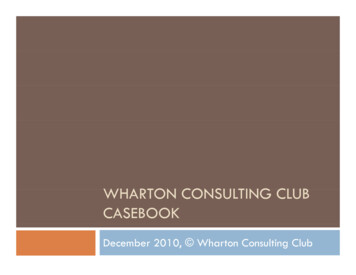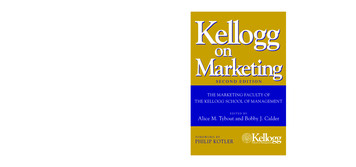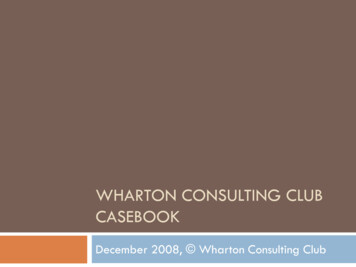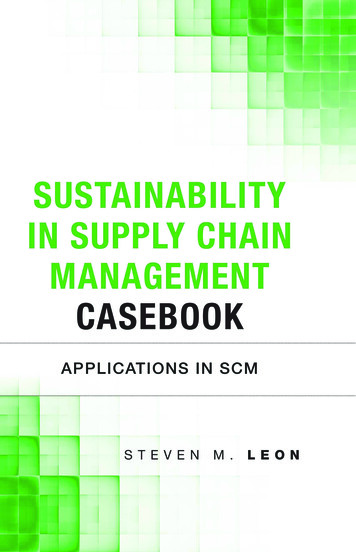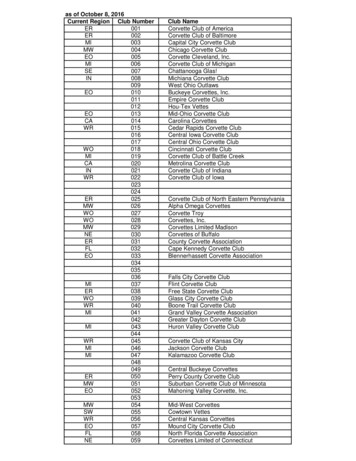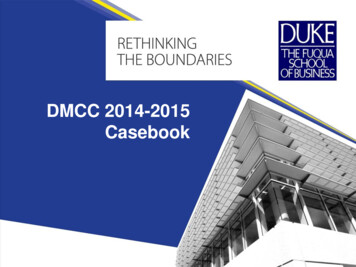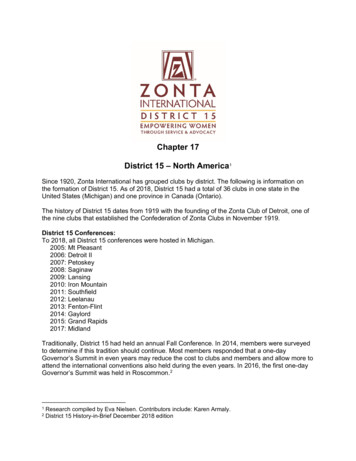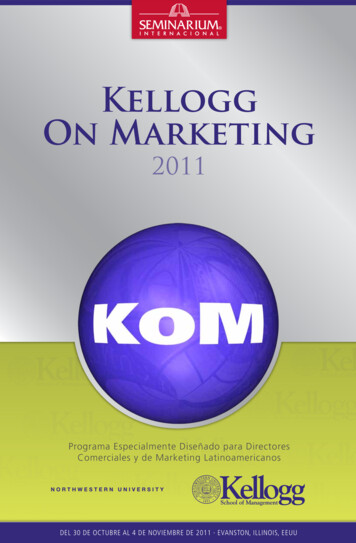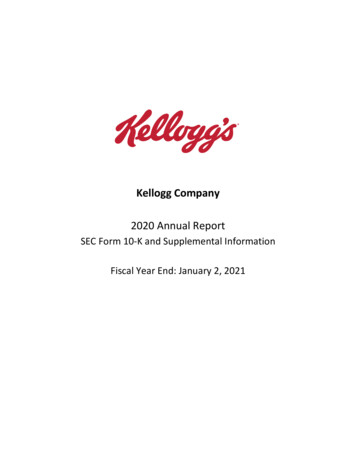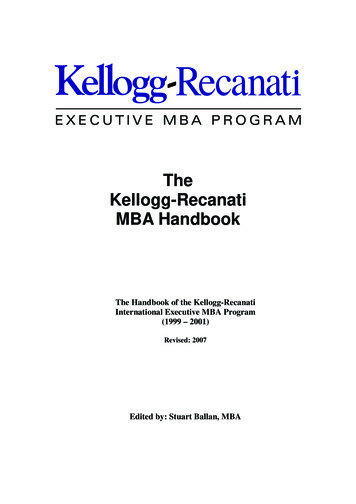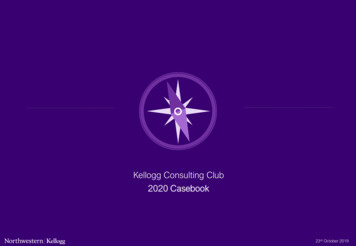
Transcription
Kellogg Consulting Club2020 Casebook23rd October 2019
Welcome to the Kellogg Consulting Club 2020 Casebook!Over the summer of 2019, we made both major and minor changes to the Casebook. Changes have been made in response to feedback in theSpring 2019 KCC survey from 2019 and 2020 consulting candidates. The headline objective has been to bring more structure to the cases tobenefit both interviewees and interviewers alike. A sample of changes is provided below: Fit questions: Appropriate Fit or Experience questions have been introduced at the beginning of every case. Case navigation: The first page of every case features a numbered list that now clearly aligns with subsequent case solving steps. Print-friendly: Exhibits now immediately follow the Case title page to facilitate economical printing of the most critical pages only. Case curriculum: A curated list of 25 cases and proposed timeline for traditional internship candidates (page 7). References: Easily searchable 3-character reference numbers simplify identification of desired cases by industry, business concept etc. Hyperlinks: Case contents now link to the relevant page of the Casebook. Difficulty ratings: Subjective case difficulty ratings have been removed with the intention to introduce evidence-based ratings next year. Cases archived: Removal of several cases deemed unpopular or out-of-date. Clear call-outs: For McKinsey-style interviewer-led cases, prompts to hand candidates Exhibits etc. Eco-friendly: Reduction in number of full-color pages and introduction of low-ink exhibits that are easy to read in black and white.Please don’t hesitate to contact us with any questions, suggestions or corrections that you may have regarding the Casebook.Rohan MainiKellogg 2020KCC VP Training2
ContentsAll contentsWelcome to the KCC 2020 Casebook!2How to use this book6Planning your case preparation7Understanding individual case pages9Finding cases13Getting the most out of a case17Evaluating case performance202020 Cases*22*See next page for detailed case contents3
ContentsDetailed case contentsCasePageCase typeIndustryBusch’s Barber Shop NEW!23Market entryHospitality & LeisureChic Cosmetology34Market entryHospitality & LeisureChicouver Cycle43Market entryTransportation & LogisticsDark Sky55New productAerospace & DefenseDigiBooks66Market entryRetail & CPGEvents.com NEW!76ProfitabilityTechnologyGarthwaite Healthcare86ProfitabilityHealthcareHealth Coaches94OperationsHealthcareHealthy Foods104Growth StrategyRetail & CPGHigh Q Plastics115ProfitabilityEngineering & ConstructionKellogg in India127Market entryGovernment & Public SectorMaine Apples138New productAgriculture & FoodMoney Bank Call Center144Cost reductionLegal & Professional ServicesMontoya Soup151ProfitabilityRetail & CPGMustard Clinic NEW!163OperationsHealthcareOrrington Office Supplies173OperationsEngineering & ConstructionPlastic World183Mergers & AcquisitionsPrivate EquityRotisserie Ranch192New productRetail & CPGSalty Sole Shoe199ProfitabilityRetail & CPGFormat (interview Interviewer-led4
ContentsDetailed case contents (continued)CasePageCase typeIndustryFormat (interview lead)Sosland Sports NEW!209Market entryHospitality & ulture & FoodVitality Insurance233ProfitabilityFinancial ServicesWildcat Wings243OperationsTransportation & LogisticsWine & Co253Opportunity AssessmentAgriculture & FoodWinter Olympics Bidding263Opportunity AssessmentEntertainment & MediaZephyr Beverages271Mergers & AcquisitionsRetail & CPGZoo Co278Mergers & AcquisitionsFinancial Services5
How to use this book6
Planning your case preparation Cases are of increasing difficulty(as determined subjectively by theKCC Exec team) so don’t feeldejected if you feel as thoughyou’re not getting better at casingModerateStraightforward cases that challengecandidates’ reliance on pre-cannedcase-frameworksNovemberBreak The Curriculum features 25 cases,but this is by no means a minimumnor a maximum number ofsuggested casesEasyCases selected to build familiarity withthe case interview process (primarilyprofitability and cost cutting)HardComplex ‘pressure’ cases that challengemultiple skills and cannot be solved withtraditional frameworks.Winter Break The curriculum is provided tosupport case selection forpractice but is completely optionaland in no way requiredEarly Jan New in the 2020 casebook, theCase Curriculum provides a list ofcases curated by the KCC Execteam to give candidates a widerange of ‘classic’ and ‘unusual’cases from a variety of industriesand CasebooksSeptember / OctoberCase curriculumConfidence BoostersCases selected to encourage customframework creation. No major complexityahead of impending interviews.CaseCasebookDigiBooksKellogg 2020Dark SkyKellogg 2020Zephyr BeveragesKellogg 2020Sosland SportsKellogg 2020Orange Yoga StudioFuqua 2014Maine ApplesKellogg 2020Chic CosmetologyKellogg 2020Goodbye HorsesFuqua 2016LifeRenewHaas 2015California Parking LotColumbia 2017TacotleKellogg 2020Orrington Office SupplyKellogg 2020Mexico City Airport Taxi ServicesWharton 2009Garthwaite HealthcareKellogg 2020Salty SoleKellogg 2020Mustard ClinicKellogg 2020Desert CityYale 2013CoyotesFuqua 2014Rock BandColumbia 2017Ski ResortBCGContact Lens ManufacturerDarden 2011Supermarket Deli TurnaroundBCGMaldovian CoffinsMcKinsey7
Planning your case preparationUse of a single casebook alone is unlikely to prepare you adequately for success in the interviewroom. Suggested resources to supplement this casebook with include:Other school casebooksMost popular with KelloggStudents: Fuqua 2014,Sloan 2011, Wharton 2012Firm representativesFor internship applicants,cases with firm reps tend tohappen in Dec and early JanSponsored studentsFirms make sponsored studentsknown at Presentations or on theirschool recruiting webpagesRecorded case interview analysisAsk your IPG leader for moreinformation on these (eg. VictorCheng LOMS)Casing textbooks‘Case Interview Secrets’ and‘Case in Point’ help get startedwith basic cases early onReading casesRegularly reported to be a usefulway to quickly gain broad case‘experience’ when working alone8
Understanding individual case pagesThe Case title page contains details that help inform case selection1324561FormatCalls out interviews that follow the McKinsey-style, interviewer-led case format2Concepts testedProvides a reference to the main concepts that the case tests (see page 16 for more information)3Primary sectorsProvides a reference to the primary sectors involved in the case (see page 14 for more information)4Case typeProvides a reference to the predominant case type (see page 15 for more information)5Similar casesProvides examples of cases that test similar concepts as this case6Additional informationContains miscellaneous information about the case9
Understanding individual case pagesThe Interviewer guide provides interviewers with a summary of the case structure121Case promptThis is the information that is provided up front to the interviewee; it introduces the key case context andheadline problem that the interviewee is to answer in the course of the case2Interviewer guideThis section provides a 30-second summary on how the case can be solved. Numbered list not onlyprovides an ideal list of steps to solve the case, but aligns exactly with subsequent areas of the case thatmay be covered during the course of the interview10
Understanding individual case pagesThe Interview prompt page contains all pre-structure information1231Fit/Experience questionNew this year, fit questions (experience for Interviewer-led cases) are provided ahead of each case2Case promptAs summarized on the previous slide, this section introduces the key case context and headline problem3Clarifying informationProvides additional pieces of information that should be provided to the interviewee if requested11
Understanding individual case pagesCase solving pages are broken down into numbered parts1231Part numberNew to the 2020 Casebook, each part number aligns with the numbered list on the interviewer guide (seepage 10 for more information)2Interviewer promptsAbove the dotted line, interviewer guidance (including instructions about when to provide the intervieweewith Exhibits) and contextual / problem voiceover is provided.3SolutionBelow the dotted line: full working, part solutions, takeaways and interviewee assessment criteria areprovided.12
Finding casesIntroduction Consultancies hiring for generalists typically issue a wide range of cases from random industries,functions or problem areas. If you are interviewing with a boutique consultancy or specific practice area, you should expect tosee a higher proportion of cases that are directly related to the type of work they do. Forexample – ‘ZS Associates’ cases skew towards pharmaceutical industry clients– ‘BCG Digital Ventures’ cases typically involve a technology problem In the KCC Casebook, each ‘Case title page’ contains details that help inform case selection toaid easy searching for cases that test a certain industry sector, case type or concept. Thecasebook uses three character references to aid ‘Ctrl F’ searching across ‘Case title pages’ (seepage 9 for more information). A list of references is provided in the next three pages.13
Finding casesIndustry sectorsIndustriesDescriptionX01 Aerospace & DefenseProduction, sale, and service of commercial vehicles, military weapons and systems designed to operate on land, sea,and air. Also includes production of aircraft and space vehicles (usually satellites) for both military and commercial use.X02 Agriculture & FoodAgriculture, husbandry or farming, is activity of cultivating plants, animals, and other life forms for food, fiber, and fuel.X03 Energy, Utilities & MiningUtilities provide basic amenities, such as water, sewage services, electricity and natural gas. Mining companies locateand extract metal and mineral reserves, then used in jewelry-making, industrial applications, and investments.X04 Engineering & ConstructionConstruction of buildings, civil engineering projects, and other industrial plant construction. The industry includeshighway, tunnel, bridge, and other civil engineering operations, as well as commercial, residential and industrial buildings.X05 Entertainment & MediaComprised of businesses that produce and distribute motion pictures, television programs and commercials, streamingcontent, music and audio recordings, broadcast, radio, book publishing, video games and supplementary servicesX06 Financial ServicesFinancial services are provided by the finance industry, which encompasses a broad range of businesses that managemoney, including banks, credit-card companies, insurers, accountancies, stock brokerages and investment funds.X07 Government & Public sectorIncludes public goods and governmental services such as law enforcement, public infrastructure, transit, and education,X08 HealthcareThe healthcare sector consists of companies that provide medical services, manufacture medical equipment or drugs,provide medical insurance, or otherwise facilitate the provision of healthcare to patientsX09 Hospitality & LeisureThe leisure and hospitality industry sector includes a broad category of fields within the service industry such as lodging,food services, event planning, theme parks, transportation and other tourism oriented products and services.X10 Legal & Professional ServicesProfessional services are occupations in the tertiary sector of the economy requiring special training in the arts orsciences. Some professional services require holding professional licenses such as architects or lawyers.X11 PharmaceuticalsThe pharmaceutical industry discovers, develops, produces, and markets drugs for use as medications to beadministered to patients, with the aim to cure them, vaccinate them, or alleviate the symptoms.X12 Retail & CPGRetailers sell products, mainly consumer packaged goods (CPG) to end users/consumers. CPG refers to a broadspectrum of manufacturers, sellers, and marketers of (typically packaged) physical goods.X13 TechnologyBusinesses involved in manufacturing of electronics, creation of software, computers or products and services relating toIT. The technology sector offers a wide arrange of products and services for consumers and businesses.X14 TelecommunicationsComprised of companies that make wireless or wired communication possible on a global scale, (eg. phone, internet)X15 Transportation & LogisticsTransportation and logistics involves planning, implementing, and controlling movement and storage of goods.14
Finding casesCase typesCase TypeDescriptionY01 Cost reductionIdentifying internal or external costs that are out of lineY02 Growth strategyIdentifying ways in which a firm can optimally growY03 Mergers & AcquisitionsEvaluating whether a firm should merge or purchase another companyY04 New product / Market entryAnalyzing a firm’s opportunity to expand into a new product, business or segmentY05 OperationsIdentifying problems in internal or customer-facing processesY06 Opportunity assessmentExamining the potential purchase / sale of a new or existing business or installation / abandonment of infrastructureY07 ProfitabilityAnalyzing causes for recent drop in profits / ways to increase profits15
Finding casesQualitativeQuantitativeBusiness conceptsBusiness ConceptDescriptionZ01 AccountingTests some aspect of accounting. Typically, this will be a simple Income Statement, Balance Sheet or Statement of Cashflows. Most common concept tested is depreciation/amortization.Z02 Net Present ValueTests ability to calculate the net present value of cash flows over time (or at a point in time). Usually in the context ofinvestment, market entry or company acquisition case.Z03 Breakeven analysisGenerally used in market entry cases, break-even analysis tends to test ability to determine how many units (or whatprice) a product should sell in order to cover a fixed cost.Z04 CapacityTests understanding of production capacity, in particular long and short run considerations.Z05 ElasticityTests understanding of price elasticity of demand or supply, usually in the context of price changes’ impact on quantitysold and by extension revenue.Z06 MacroeconomicsTests understanding of macroeconomic variables trends than affect businesses including: inflation, foreign exchangerates, recessions, international trade.Z07 Market shareTests understanding of the client and its competitors’ market share. This may include understanding of typical features ofconcentrated and fragmented markets.Z08 Market sizingTests ability to develop a structured approach to sizing a market. Emphasis is on mathematical approach rather thanaccurate estimation of market size or dependent variables.Z09 MicroeconomicsTests understanding of microeconomics, for example the role of demand and supply in market pricing.Z10 Customer marketing strategyTests understanding of marketing to customer segments. May involve analyzing their needs, WTP, buying decision,preferred distribution channel etc.Z11 Competitive analysisTests ability to analyze relevant aspects of the competition in relation to the client’s business situation.Z12 CreativityTests ability to develop creative options, usually as part of a brainstorming exercise.Z13 Organizational changesTests ability to develop recommendations around the organizational structure, people and/or culture.Z14 Pricing strategyTests ability to develop options and methodologies to price a new product or reprice an existing one.Z15 Supply/value chainTests understanding of players and activities involved in sale of a product, from the delivery of source materials fromsuppliers to manufacturers, to delivery to the end user.Z16 Vertical integrationTests ability to develop a practical solution involving vertical integration of the supply chain.16
IntervieweeGetting the most out of a caseInterviewerBest practices before a caseShare focus areasInform your interviewer of anyspecific areas that you wouldlike feedback onShare your caselogShare an up-to-date caselogwith your interviewer so youdon’t accidently repeat a caseDon’t sneak a peek!Replicate a real-life caseinterview experience by goingin completely in the darkBring materialsBring several sheets of blankpaper and a pen or pencil tothe meetingBrush up on the industryReview unfamiliar industrieswith KCC’s industry primers oronline (eg. Vault.com)Review the caseFamiliarize yourself with thecase ahead of time to avoidhaving to check guidanceDo the math beforehandGain practice with the mathrequired and understandwhere common traps may liePrint exhibitsInterviewers should bringprinted out copies of anyexhibits needed for the case17
IntervieweeGetting the most out of a caseInterviewerBest practices during a caseTake it seriouslyYou might be interviewing with a friend, buta formal atmosphere will be more valuableand provide a realistic interview experienceKeep quiet!While silence may be uncomfortable, resistthe urge to jump in with pointers, hints, oradditional informationAsk fit questionsAlmost all interviews start with fit orExperience questions, so the KCC nowprovides such a suggested question beforeeach case prompt18
IntervieweeGetting the most out of a caseInterviewerBest practices after a caseProvide high-level performance assessmentBe honest with the interviewee about theirperformance. If it was a good case, tellthem. If it was poor, it’s even moreimportant to tell them!Provide detailed feedbackAfter providing a high-level performanceassessment, explain why by running theinterviewee through each part of their caseGive feedback!A case is a two-sided conversation. Tell theinterviewer how they could do anythingdifferently in terms of case or performanceassessment delivery19
Evaluating case performanceEvaluation criteriaCase skills and driving the caseProblem definitionClearly understands and defines the problem/ question; summarizes the essence of the issueProblem breakdownBreaks problem into most important componentsStructureUses a structured and thoughtful approach to solve the problem (e.g. draw issue tree with critical pieces ofanalysis)PrioritizationIdentifies critical path to the recommendation and most important issues/componentsInformationIdentifies and addresses key pieces of information and assumptions needed to solve the problemSolution orientedFormulates hypothesis when needed and maintains focus on the recommendation80-20 approachDeep dives into identified critical issues to develop a recommendation (80% of solution with 20% of analysis)RecommendationEnds up with a pragmatic/ realistic solution that answers the initial question; supported with the analysisCommunication skillsStructureShares thinking process throughout the case and aligns his communications with the structure of the caseFocusHighlights key insights, important findings and critical issuesQuestionsAsk clear questions related to the case process and solutionEngagementEngages with the interviewer during the solution of the caseSupportClearly supports any conclusion or important claim with relevant argumentsBusiness languageFeels comfortable discussing the case with business terminologyBody languageCommunicates naturally and uses body language to support the communication processGradeGrade20
Evaluating case performanceEvaluation criteria (continued)Polish and interpersonal skillsSelf confidenceShows confidence when solving and attacking the case without sounding arrogantQuantitative skillsFeels comfortable handling complex calculations and analytics; shows clear calculations and data framingAnalysisDeep dives in identified critical issues or components and comes up with a solution for each issueInterpersonal skillsDrive a conversation and acts naturallyBalanceGood balance of quantitative and qualitative analysis during the solutionBusiness sense and high level thinkingCreativityIdentifies or uses different approaches to solve the problem. Out of the box thinking; uses creative methodsand arrives at creative solutionsSynthesisSummarizes key findings through the solution of the case and translates them into insights or important takeawaysConceptsClearly understands and uses the key business concepts to solve the case“So what” thinkingClearly addresses and articulates what each analysis, conclusion or recommendation means to the case,solution or the clientTestingFrequently tests assumptions and conclusions with reality checks or other quick analysisAssessmentAssesses risks and consequences for the recommendations; identifies key next steps to further prove thesolutionBusiness senseUses common sense and realistic thinking to get to pragmatic recommendations; has the ability to think fromdifferent perspectives (e.g. client, competitor, consumer, etc.)GradeGrade21
2020 Cases22
Case 01Busch’s Barber ShopConcepts testedPrimary sector(s)Similar cases Z08 Market sizing (2) X09 Hospitality & Leisure Snack Foods Acquisition(Columbia 2017) Z12 Creativity (5) Surfboard Wax in Hawaii(Fuqua 2014)Case type Y04 Market entry Chic Cosmetology (Kellogg2020) Y06 Opportunity assessmentCase author(s): Michael Eidem (Kellogg 2020)Edited by: Rohan Maini (Kellogg 2020)23
Busch’s Barber ShopInterviewer guideCase Question Your friend, a current MBA student, has his heart set on starting a barbershop in Evanston after graduation. There are plenty of barbershops and salons near the Northwestern campus, but your eager friend argues they are either (A) vastlyoverpriced or (B) cheap, but really low quality. He wants your help coming up with a plan.Interviewer guide Problem: Develop a market entry strategy for Busch’s Barber Shop Key case steps:1. Develop a structure to address the problem2. Confirm market attractiveness (size)3. Calculate revenue and costs for two potential locations4. Evaluate profitability of potential loyalty program5. Brainstorm other areas of consideration6. Provide client recommendation24
Busch’s Barber ShopFit: Tell me something about yourself that is not on your resume.Case Question Your friend, a current MBA student, has his heart set on starting a barbershop in Evanston after graduation. There are plenty of barbershops and salons near the Northwestern campus, but your eager friend argues they are either (A) vastlyoverpriced or (B) cheap, but really low quality. He wants your help coming up with a plan.Clarifying information Customers: For this analysis, your friend wants to focus solely on a target market of the male population of Evanston. Competitive dynamics: Highly competitive, segmented into two distinct groups (high price & low price). Friend believes there is aprofitable space in between these two segments. Market: Growing at GDP the past five years. Your Friend: No specific experience in the cosmetology area, has enough savings to fund initial upfront costs and early ongoingcosts. Profitability is the main goal in the short term (wants to be profitable in year one to justify his decision not to take a highpaying consulting job). Product: Barbershop only intends to initially sell haircut service. Any other additional products or services can be considered in thefuture.25
Busch’s Barber ShopExhibit A – Market analysisWhere do men in Evanston gettheir haircut?Competitors’ market share100%80% ,33%10%10%25%20%60% ,67%40%20%35%30%30%40%0%Low-endHigh-endNotes: Men’s haircut market split between two groups, high-end (avg price 50) and low-end (avg price 20). Evanston Adult Population: 60k (50% male)26
Busch’s Barber ShopExhibit B – Market Entry ProjectionsExpected Customer StealDescriptionUpfront CostsOngoing Location #1Downtown10%5% 30k 20k 4k4 workers, 15/hrLocation #2Not Downtown5%5% 30k 25k 1k2 workers, 15/hrNotes: Projections of customer steal based on consumer survey. Survey described new barbershop as in-between quality at pricepoint of 30.27
Busch’s Barber ShopPart 11. Develop framework for how to approach this new ventureA sample case structure would include the following: Client: Specific goals, strengths, capabilities, resources Market: Size, growth, competition, customer segmentation Profitability Expected customer volume, target customers Price elasticity, pricing method (ex: loyalty), service mix Costs: Fixed costs (rent, equipment, merchandise, advertising), variable costs (labor) Go-to strategy: Build, acquire, partner with additional co-owner Barriers: Capital, local regulations, attracting talent Risks: Competitive response, no differentiation, opportunity costFollowing discussion of framework, interviewee should be asked to briefly market size the adult men’s haircut market in Evanston(See next page)28
Busch’s Barber ShopParts 2-32. Confirm market attractiveness (size)Interviewee should make educated guesses regarding: City population size ( 60k) Male/female ratio ( 50/50) What % of male population pays for haircuts (i.e. likelyomitting young kids, those who cut their own hair, bald men)3. Calculate revenue and costs for two potential locationsProvide Exhibits A & BYour friend thinks there is a profitable middle ground betweenthe low cost/low quality cut and the high cost/high quality cutmarkets. What % of men in Evanston get their haircut in Evanston vsdowntown Chicago near their place of work.Additional information: Average annual haircuts per person being considered Barbershop will be open 10 hours/day, 360 days/year Price segmentation (average price for cut, high end vs lowend portions of the market and distribution between the two) Assume customers stay with the same barbershop once theymake a decision (i.e. customers don’t switch back and forthbetween shops). End result should be a total annual dollar amount spent onhaircuts by men in Evanston.There is no correct answer to this exercise. A good intervieweewill show creativity, structure, and intuition regarding makingeducated guesses. Push interviewee to move quickly since thisis not the primary purpose of the overall case. An average male in Evanston pays for 10 haircuts per yearLead interviewee towards calculating 1st year profit in eachlocation to determine optimal choice [see next page forsolution].29
Busch’s Barber ShopPart 3 (continued)3. Calculate revenue and costs for two potential locations (Exhibit A & B)Adult male population count in each segment:MarketAdult Male CustomersLow-end 60k * 50% * 2/3 20kHigh-end 60k * 50% * 1/3 10kProjected revenue calculation of each location:LocationTotal Customers StolenDowntown 20k*10% 10k*5% 2.5kNot Downtown 20k*5% 10k*5% 1.5kRevenue 2.5k * 10 cuts/yr * 30/haircut 750k 1.5k * 10 cuts/yr * 30/haircut 450kCost calculations of each location:LocationUpfront CostsDowntown 30k 20k 50kNot Downtown 30k 25k 55kLabor 4* 15/hr*10hr/day*360days 216k 2* 15/hr*10hr/day*360days 108kFirst year profitability:LocationDowntownNot DowntownRevenue 750k 450k-Rent 48k 12kTotal Cost 314k 175k Total 314k 175kProfit 436k 275kTakeaway: Downtown location has higher projected first year profits.Optional brainstorming question: What other factors should be considered when choosing a potential shop location?Potential answers: Long term plans, proximity to other stores, ease of transportation to location, visibility, layout of store, capacityconstraint for future growth, preference of target demographic30
Busch’s Barber ShopPart 44. Evaluate profitability of potential loyalty programYour friend (after having chosen the downtown location) is considering implementing a loyalty reward system as part his marketingstrategy. He’s decided that such a system would reward customers by giving them their 10th haircut for free. He projects this willresult in a 10% increase in total first year customers. Is this a profitable decision?One method is to calculate the new annual customer count, determine expected annual revenue, and compare with previouslycalculated revenue. Costs assumed to remain constant since no marginal costs for additional haircuts (employees paid hourly,assume no additional employees required).New expected annual customer count: (Previously calculated total customers) * 110% 2500 * 1.1 2750 customersExpected revenue with loyalty program: (# of expected customers) * (average # haircuts paid for annually) * (price) 2750 * (10 – 1) * 30 742.5kTakeaway: Revenue without loyalty program was 750k. Since costs do not change, not profitable decision.Additional insight: Revenue decline is minimal ( 1%), are there potential advantages of increasing customer base by 10% that wouldstill make implementing loyalty program attractive? (example: implement loyalty program for only the first year to build customer base,upsell products such as shampoo/additional services to this larger customer base, etc.)31
Busch’s Barber ShopPart 55. Brainstorm other areas of consideration (optional)Additional optional brainstorm questions:1. What changes could be made to make this loyalty program profitable? Decrease frequency of freebies, make reward 50% off instead of free cut, etc.2. Instead of the loyalty program, your friend is considering introducing a membership-based pricing. In this system, a customerwould pay a set price every month for unlimited haircuts. What are pros and cons of such a system, and if it was implemented,how would you think about setting the price? Pros (more predictable revenue stream, potentially increased data on customers, differentiation) Cons (adverse selection likely to occur with only customers who would overuse membership signing up, potentially unhappyemployees if tips reduce based on different payment scheme)3. One key to success will be finding quality employees without having to pay as high of a base wage as high end competition. Whatare some possible me
Welcome to the Kellogg Consulting Club 2020 Casebook! Rohan Maini Kellogg 2020. KCC VP Training. Over the summer of 2019, we made both major and minor changes to the Casebook. Changes have been made in response to feedback in the Spring 2019 KCC survey from 2019 and 2020 consulting candidates. The headline objective has been to bring more .
